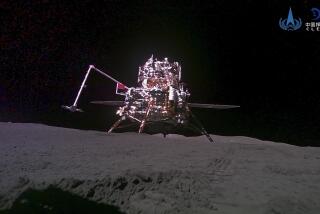Indian lunar spacecraft reveals indigenous water from inside moon
- Share via
Scientists using a NASA instrument aboard an Indian spacecraft have discovered signs of water native to the moon – not brought from far away, but water that must have been locked beneath the lunar crust since its birth.
The discovery by the ill-fated Chandrayaan-1 lunar probe represents the first time researchers have found signs of native water remotely. The results, published in the journal Nature Geoscience, offer further evidence that the moon has its own indigenous source of water.
Previously, researchers have relied on rock samples brought back by Apollo astronauts to find out about the moon’s internal moisture (drier than earthly deserts but wetter than we used to think.) That’s because orbiting satellites are unable to peer beneath the surface, and what water they see on top has been implanted, either by the solar wind or by micrometeorites hitting the surface.
But the crater Bullialdus, with its unusual chemical diversity, offered an ideal spot to peer into the moon’s depths without sending an astronaut with a shovel. The area, near the moon’s equator, is the site of some serious double-digging: It sits in the Mare Nubium, a lunar plain that was probably carved out by a major impact.
Bullialdus is 61 kilometers wide and probably was carved out after an asteroid smashed into the moon, excavating 6 to 9 kilometers. Like many craters, it has a central peak in the middle. When an asteroid whams into the surface, the ground essentially rebounds, pushing up a bunch of rock from underground.
Using data from the spacecraft’s NASA Moon Mineralogy Mapper, researchers discovered an abundance of hydroxyl in the crater’s central peak – essentially water that’s been trapped in chemically stunted form. The signal seemed too strong to be the sparse stuff left on the surface by solar wind, the researchers surmised, and must be a remnant of water chemically bonded to the magmatic rock in which it was sealed.
With these findings in hand, scientists may be able to expand on the conclusions drawn from rock samples from the Apollo sites, which were all clustered on one part of the moon.
The work is one of the findings to come out of India’s 2008 Chandrayaan-1 probe, which survived 312 days of its planned two-year mission.







